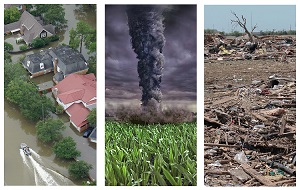
Natural Disasters Resulting in Catastrophic Pollution Releases
Last year was a record-breaking year for billion-dollar disasters, highlighting the importance of environmental insurance
Last year marked a new record for severe weather and climate events, with 28 natural disasters totaling over a billion dollars in damages, reports National Oceanic and Atmospheric Administration (NOAA). These disasters include floods, wildfires, winter storms, tornadoes, tropical cyclones, and “super storms.” Such severe weather events cause extensive damage to businesses, sometimes resulting in environmental pollution that leads to significant cleanup costs and liability issues.
Imagine a scenario where a tornado destroys a warehouse full of chemicals, leading to poisonous chemicals contaminating groundwater. Power outages from such events can also induce critical situations, like chemical reactions resulting in toxic gas releases at a chemical manufacturing plant. This damage can extend to third-party premises and nearby residents, leaving the business liable.
Commercial General Liability and Property policies often exclude Pollution releases; if included, it’s typically insufficient. Small and medium-sized enterprises (SMEs) are particularly vulnerable, as they risk dealing with uninsured losses. Environmental damages can result in costly cleanup fees, lawsuits, fines, penalties, and business losses due to property damage or work interruption.
Insurance agents can help their clients plan for potential issues resulting from natural disasters. The first step is to determine what environmental exposures the business has, and the availability of coverage for those exposures. An agent will also want to spend time reviewing a client’s disaster preparedness plan as a tool for assessing their pollution exposures. What is the insured’s plan in the event of a major flood? What is their contingency if the roof is blown off? What is their water intrusion or mold management plan? This will help inform a conversation about coverage to address the insured’s specific needs. Once the scope and cost of available coverage has been determined, it becomes a simple risk management conversation. Is the cost of transferring the risk identified as worthwhile, or is it better to retain the exposure and “self-insure”?
With the recent uptick in severity of natural disasters, businesses and property owners are becoming more concerned with what happens in the aftermath of such an event. A solid insurance program should be part of this planning. For more information or to discuss a specific account, please contact us.
Want to learn more about natural disasters and environmental insurance? Check out some of our other articles on this topic:
Changing the Equation: How Natural Disasters Increase Everyone’s Pollution Risks
How Natural Disasters are Changing the Way We Think About Insurance
Type: Blog
Topic: flood, hurricane, natural disaster, pollution and weather, wildfire